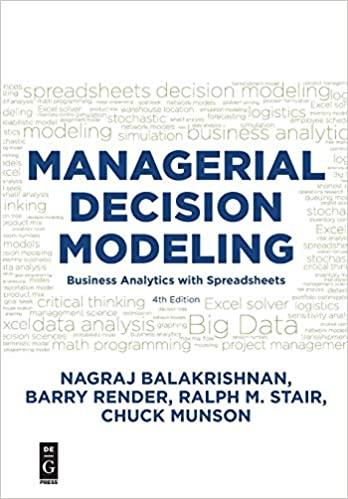Question
Question 1 Bell Inc.'s perpetual preferred stock sells for $105 per share, and it pays an $9 annual dividend. If the company were to sell
Question 1
Bell Inc.'s perpetual preferred stock sells for $105 per share, and it pays an $9 annual dividend. If the company were to sell a new preferred issue, it would incur a flotation cost of 5.00% of the price paid by investors. What is the company's cost of preferred stock?
Group of answer choices
7.5%
9%
10%
8%
Question 2
Bell Inc. has the following data: rrf = 4.00%; RPM = 7.00%; and beta= 2. What is the firm's cost of equity from retained earnings based on the CAPM?
Group of answer choices
15%
18%
9%
10%
Question 3
Assume that you are a consultant to Bell Inc., and you have been provided with the following data: D0 = $0.67; P0 = $47.50; and g = 8.00% (constant). What is the cost of equity from retained earnings?
Group of answer choices
9.4%
9.5%
9.6%
9.3%
Question 4
Assume that you are a consultant to Bell Inc., and you have been provided with the following data: D0 = $0.67; P0 = $47.50; and g = 8.00% (constant). The flotation cost is $4 per share. What is the cost of new common stock?
Group of answer choices
9.8%
9.6%
9.5%
9.7%
Question 5
Assume that you are a consultant to Bell Inc., and you have been provided with the following data: D0 = $0.67; P0 = $47.50; and g = 8.00% (constant). The flotation cost is 5% of the price. What is the cost of new common stock?
Group of answer choices
9.6%
9.8%
9.5%
9.4%
Question 6
You were hired as a consultant to Bell Inc., whose target capital structure is 30% debt, 15% preferred, and 55% common equity. The new long-term debt before tax cost is 8.00%, the cost of preferred is 7.50%, and the cost of retained earnings is 11.50%. The firm will not be issuing any new stock. The tax rate of the firm is 25%. What is its WACC?
Group of answer choices
9.5%
9.4%
9.25%
9.32%
Question 7
You have obtained the following data: (1) rd = yield on the firm's bonds = 7.00% and the risk premium over its own debt cost = 4.00%. (2) rRF = 5.00%, RPM = 6.00%, and = 1.65. (3) D1 = $1.20, P0 = $35.00, and g = 8.00% (constant). You were asked to estimate the cost of equity based on the three methods and then to indicate the difference between the highest and lowest of these estimates. What is that difference?
Group of answer choices
3.90%
4.60%
4.29%
4.21%
Question 8
Which of the following is NOT a capital component when calculating the WACC ?
Group of answer choices
Corporate bond
Common stock
Retained earnings
Account payable
Question 9
For a typical firm, which of the following sequences is CORRECT? All rates are after taxes, and assume that the firm operates at its target capital structure.
Group of answer choices
re> rs > rp> rd
rp > rd > rs > re
rp > re > rs > rd
rs > re > rd > rp
Question 10
Which of the following statements is CORRECT?
Group of answer choices
All else equal, an increase in a company's stock price will increase its marginal cost of retained earnings, rs.
If a company's tax rate increases but the YTM on its noncallable bonds remains the same, the after-tax cost of its debt will fall.
Since the money is readily available, the after-tax cost of retained earnings is usually much lower than the after-tax cost of debt.
All else equal, an increase in a company's stock price will increase its marginal cost of new common equity, re.
Step by Step Solution
There are 3 Steps involved in it
Step: 1

Get Instant Access to Expert-Tailored Solutions
See step-by-step solutions with expert insights and AI powered tools for academic success
Step: 2

Step: 3

Ace Your Homework with AI
Get the answers you need in no time with our AI-driven, step-by-step assistance
Get Started


